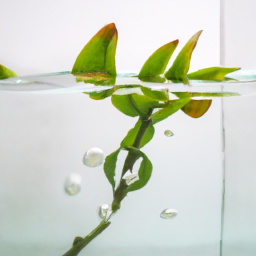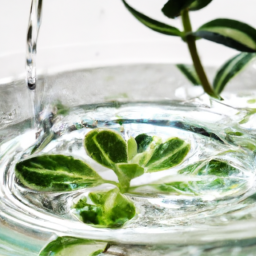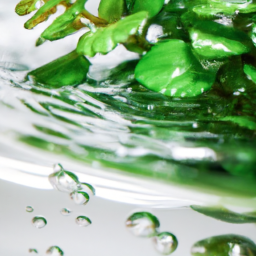
Hey there plant lovers! Are you tired of dealing with messy soil and constant watering for your indoor plants? Well, we have a solution for you – indoor plants in water! Yes, you heard it right. Forget about the hassle of soil and say hello to a whole new way of growing and caring for your favorite plants. In this blog post, we will explore the fascinating world of indoor plants in water and discover the benefits, types of plants that thrive in water, and how to care for them. So, grab a cup of tea, sit back, and let’s dive into the wonderful world of indoor plants in water!
Benefits of Growing Indoor Plants in Water
Indoor plants not only add beauty to our living spaces but also provide numerous benefits for our well-being. One popular method of growing indoor plants is in water, also known as hydroponics. This technique offers several advantages over traditional soil-based gardening. In this article, we will explore the benefits of growing indoor plants in water and provide you with a step-by-step guide to get started.
Improved Air Quality
Growing indoor plants in water helps to purify the air in our homes by increasing humidity levels and removing toxins. Plants naturally release moisture through a process called transpiration, which can help combat dry indoor air. Moreover, they absorb harmful pollutants such as formaldehyde, benzene, and carbon monoxide, improving the overall air quality. By having a few water-based indoor plants strategically placed, you can create a healthier environment for you and your family.
Furthermore, certain plants are particularly effective in removing specific toxins. For example, spider plants are known to be excellent at removing formaldehyde, while peace lilies are great at eliminating benzene. By selecting the right plants for your space, you can target specific toxins and further enhance the air quality in your home.
In addition to their air-purifying properties, indoor plants in water also act as natural humidifiers. They release moisture into the air, which can be especially beneficial during the dry winter months or in areas with low humidity. This can help alleviate dry skin, respiratory issues, and even reduce the spread of airborne viruses.
Easy Maintenance
One of the significant advantages of growing indoor plants in water is the ease of maintenance. Unlike traditional potted plants that require regular soil checks and watering schedules, water-based plants are relatively low maintenance. Once you set up the hydroponic system correctly, you can enjoy hassle-free plant care.
Since the plants are grown in water, there is no need to worry about overwatering or underwatering. The roots directly absorb the nutrients dissolved in the water, ensuring the plants receive the right amount of nourishment. This eliminates the risk of root rot, a common issue in soil-based plants.
Another benefit is that water-based plants tend to grow faster than their soil counterparts. The nutrients in the water are readily available to the roots, allowing the plants to focus their energy on growth rather than searching for nutrients in the soil. This rapid growth can be particularly satisfying for plant enthusiasts who enjoy seeing their green companions thrive.
Moreover, maintaining cleanliness is easier with water-based plants. There is no soil to deal with, reducing the chances of pests or fungal diseases. Cleaning the containers and changing the water periodically is usually sufficient to keep the plants healthy and thriving.
Enhanced Aesthetic Appeal
Indoor plants in water can add a unique and visually appealing touch to your home decor. Without the need for soil, you have more flexibility in displaying your plants creatively. You can use various glass containers, vases, or even repurpose old bottles to create stunning hydroponic setups.
The roots of water-based plants are often visible, which can be an interesting aesthetic feature. Some plant enthusiasts even add decorative elements like colored pebbles or marbles to enhance the visual appeal of their hydroponic displays. This allows you to personalize your indoor garden and create a focal point in any room.
Furthermore, water-based plants offer a wide variety of plant choices. Many popular houseplants can thrive in water, including pothos, philodendrons, lucky bamboo, and Chinese evergreen. With such a diverse selection, you can easily find plants that match your personal style and preferences.
In conclusion, growing indoor plants in water provides several benefits, including improved air quality, easy maintenance, and enhanced aesthetic appeal. By harnessing the power of hydroponics, you can create a healthier and more visually appealing environment in your home. So why not give it a try? Follow our step-by-step guide to get started on your journey of growing beautiful indoor plants in water.

Best Types of Indoor Plants to Grow in Water
Indoor plants not only add a touch of greenery to your living space but also provide numerous health benefits. Growing indoor plants in water is a popular trend as it eliminates the need for soil and can be a visually appealing addition to any room. In this guide, we will explore some of the best types of indoor plants that thrive in water, allowing you to create a stunning indoor garden.
1. Pothos
Pothos, also known as Devil’s Ivy, is a versatile and low-maintenance indoor plant that can thrive in water. This plant features heart-shaped leaves that come in various shades of green, making it a visually appealing choice for any room. Pothos is also known for its air-purifying properties, making it an excellent choice for improving indoor air quality.
To grow pothos in water, start by selecting a healthy cutting with at least two nodes. Nodes are the points where leaves emerge from the stem. Trim any leaves near the bottom of the cutting, leaving only a few at the top. Place the cutting in a glass container filled with water, ensuring that the nodes are submerged. Keep the container in a well-lit area, but avoid direct sunlight. Change the water every two weeks to prevent stagnation and promote healthy growth.
Pothos can grow long vines in water, creating a cascading effect that adds a touch of elegance to your indoor space. Once the roots are well-established, you can even transfer the plant to a hanging basket or train it to climb a trellis.
2. Lucky Bamboo
Lucky Bamboo, scientifically known as Dracaena sanderiana, is a popular indoor plant that is often grown in water. Despite its name, Lucky Bamboo is not actually bamboo but belongs to the Dracaena family. It is believed to bring good luck and prosperity, making it a common choice for home and office decor.
To grow Lucky Bamboo in water, start by selecting a healthy stalk with green leaves. Place the stalk in a glass container filled with water, ensuring that the water level covers the roots. Keep the container in a well-lit area away from direct sunlight. It is essential to use filtered or distilled water to prevent the build-up of minerals that can harm the plant.
Lucky Bamboo can be grown in a variety of arrangements, such as straight stalks, spirals, or braids. It is a slow-growing plant that requires minimal care, making it an ideal choice for beginners or those with a busy lifestyle.
3. Spider Plant
The Spider Plant, scientifically known as Chlorophytum comosum, is a popular choice for indoor gardening due to its adaptability and air-purifying qualities. This plant features long, arching leaves with white stripes, giving it a unique and attractive appearance.
To grow Spider Plants in water, start by selecting a healthy plantlet or spiderette. These are small plantlets that form on long stems extending from the parent plant. Place the plantlet in a glass container filled with water, ensuring that the bottom of the stem is submerged. You can use small rocks or marbles to stabilize the plant and prevent it from tipping over.
Spider Plants are relatively easy to care for and can tolerate a wide range of lighting conditions. However, they thrive best in bright, indirect light. Change the water every two weeks, ensuring that it remains clean and fresh. Over time, your Spider Plant will produce more plantlets, allowing you to expand your indoor garden or share them with friends.
Growing indoor plants in water can be a rewarding and visually appealing way to bring nature indoors. By choosing the right plants and providing them with the necessary care, you can create a vibrant and thriving indoor garden that adds beauty and freshness to your living space. Experiment with different plant varieties, and enjoy the benefits of having these green companions in your home.

Tips for Caring for Indoor Plants in Water
Indoor plants are a great addition to any home or office space. They not only enhance the aesthetics of the environment but also provide numerous health benefits. While most indoor plants are traditionally grown in soil, there is a growing trend of growing plants in water. This method, known as hydroponics, eliminates the need for soil and offers a unique and visually appealing way to display your plants. In this article, we will explore the tips for caring for indoor plants in water and how to ensure their health and longevity.
Choosing the Right Plants
Not all plants are suitable for growing in water. Some plants are better adapted to this method than others. When choosing plants for your indoor water garden, consider those that naturally thrive in water or have a high tolerance for it. Some popular choices include pothos, philodendron, lucky bamboo, and peace lily. These plants have adapted to water environments and can grow well without soil.
It is important to note that certain plants, such as succulents and cacti, are not well-suited for water cultivation. These plants have specialized water storage structures that are designed to survive in arid conditions. Therefore, it is best to stick to plants that are specifically known for their ability to grow in water.
When selecting plants, also consider the available space and lighting conditions in your home or office. Different plants have different light requirements, so choose plants that will thrive in the available light. Additionally, ensure that the plants you choose are of good quality and free from pests or diseases.
Preparing the Water
The quality of the water you use is crucial for the health of your indoor plants. Tap water may contain chemicals, such as chlorine or fluoride, which can be harmful to the plants. To ensure the best results, it is recommended to use filtered or distilled water.
It is also important to maintain the right water temperature. Most indoor plants prefer water that is at room temperature, around 65-75°F (18-24°C). Avoid using water that is too cold or too hot, as extreme temperatures can shock the plants and hinder their growth.
Additionally, you can add nutrients to the water to provide essential minerals for the plants. There are specialized hydroponic fertilizers available in the market that are specifically formulated for plants grown in water. Follow the instructions on the fertilizer packaging to determine the appropriate amount to use.
Planting and Maintenance
Once you have chosen the right plants and prepared the water, it’s time to plant them in their containers. Select containers that are suitable for hydroponic gardening, such as glass jars or vases. Make sure the containers have enough depth to hold the roots of the plants and provide stability.
Gently remove the plants from their nursery pots and rinse off any excess soil from the roots. Place the plants in the containers, ensuring that the roots are fully submerged in the water. You may need to use rocks or pebbles to stabilize the plants and prevent them from toppling over.
Regular maintenance is essential for the health and growth of your indoor plants in water. Keep an eye on the water level and top it up as needed to ensure the roots are always submerged. Monitor the condition of the plants and remove any dead or yellowing leaves promptly.
Every few weeks, it is recommended to change the water completely to prevent the buildup of algae or bacteria. Rinse the roots of the plants thoroughly before placing them back in fresh water. This will help maintain a clean and healthy environment for the plants.
Lastly, provide adequate light for your indoor water plants. Place them near a window where they can receive bright, indirect sunlight. If natural light is limited, you can also use artificial grow lights to supplement the lighting requirements.
By following these tips, you can successfully care for your indoor plants in water and create a beautiful and thriving hydroponic garden. Remember to choose the right plants, prepare the water properly, and provide regular maintenance to ensure the health and longevity of your plants. Enjoy the unique and visually appealing experience of growing indoor plants in water!
Let’s wrap up what we learned
Indoor plants are a fantastic way to bring life and freshness into our homes, but sometimes taking care of them can be a bit challenging. If you’re tired of dealing with soil, watering schedules, and potential mess, why not try growing your plants in water instead? That’s right, indoor plants can thrive just as well in water, and it’s a trend that’s gaining popularity among plant enthusiasts.
Growing indoor plants in water is not only a convenient alternative to traditional soil-based gardening, but it also offers several benefits. Firstly, it eliminates the hassle of dealing with soil, which means no more dirt on your floors or pots. Plus, watering becomes a breeze as you can simply keep an eye on the water level and refill as needed. Secondly, plants grown in water tend to have fewer issues with pests and diseases commonly associated with soil. This makes them an excellent choice for those who struggle with plant health or don’t have the time to constantly monitor and treat their plants. Additionally, water-grown plants can enhance the aesthetic appeal of any space, as they often display stunning root formations that create a unique visual display.
FAQ Roundup:
Q1: Can indoor plants grow in water instead of soil?
A1: Yes, many indoor plants can thrive in water instead of soil. These plants are commonly referred to as hydroponic or water-grown plants. They have adapted to absorb nutrients and moisture directly from the water, eliminating the need for traditional soil-based growth.
Q2: What are the benefits of growing indoor plants in water?
A2: Growing indoor plants in water offers several advantages. Firstly, it eliminates the hassle of dealing with soil and the associated mess. Additionally, water-grown plants tend to require less maintenance as their nutrient uptake is more efficient. Furthermore, they can serve as beautiful natural decorations, adding a touch of greenery to your indoor space.
Q3: Which indoor plants are suitable for growing in water?
A3: Several indoor plants are well-suited for growing in water. Some popular choices include pothos, philodendron, spider plants, lucky bamboo, and peace lilies. These plants have adapted to survive and thrive in water, making them excellent options for water-based cultivation.
Q4: How do I start growing indoor plants in water?
A4: To start growing indoor plants in water, you’ll need to follow a few simple steps. First, select a healthy plant cutting or a young plant with roots. Place the cutting or plant in a container filled with clean water, ensuring that the roots are submerged. Keep the container in a well-lit area, but away from direct sunlight. Change the water every few weeks to prevent stagnation and add a diluted nutrient solution to provide essential minerals for the plant’s growth.
Q5: What care do indoor plants in water require?
A5: Indoor plants in water require minimal care compared to their soil-based counterparts. Ensure that the water level remains sufficient to cover the roots and regularly change the water every two to four weeks to prevent the growth of algae or bacteria. Additionally, provide the plants with indirect sunlight or artificial grow lights to ensure they receive adequate light for photosynthesis. Lastly, monitor the plants for any signs of nutrient deficiencies and adjust the nutrient solution accordingly to maintain their health and vitality.

James Wong is a renowned ethnobotanist, plant scientist, and local television presenter. With a passion for demystifying plant science, he is known for translating complex botanical concepts into practical advice for everyday plant enthusiasts. James’s expertise spans from traditional gardening to cutting-edge plant technologies, making his insights accessible and informative.


